Book contents
- Frontmatter
- Contents
- List of contributors
- Acknowledgments
- Preface
- Part I General issues
- Part II Head and neck
- Part III Thorax
- 11 Chest wall deformities
- 12 Congenital diaphragmatic hernia
- 13 Surgical management of airway obstruction
- 14 Pulmonary resection and thoracotomy
- 15 Esophageal atresia
- 16 Antireflux procedures
- 17 Esophageal replacement
- 18 Esophageal achalasia
- 19 Congenital malformations of the breast
- Part IV Abdomen
- Part V Urology
- Part VI Oncology
- Part VII Transplantation
- Part VIII Trauma
- Part IX Miscellaneous
- Index
- Plate section
- References
11 - Chest wall deformities
from Part III - Thorax
Published online by Cambridge University Press: 08 January 2010
- Frontmatter
- Contents
- List of contributors
- Acknowledgments
- Preface
- Part I General issues
- Part II Head and neck
- Part III Thorax
- 11 Chest wall deformities
- 12 Congenital diaphragmatic hernia
- 13 Surgical management of airway obstruction
- 14 Pulmonary resection and thoracotomy
- 15 Esophageal atresia
- 16 Antireflux procedures
- 17 Esophageal replacement
- 18 Esophageal achalasia
- 19 Congenital malformations of the breast
- Part IV Abdomen
- Part V Urology
- Part VI Oncology
- Part VII Transplantation
- Part VIII Trauma
- Part IX Miscellaneous
- Index
- Plate section
- References
Summary
Chest wall deformities fall into two categories; those in which there is overgrowth of the ribs and cartilages causing either a depression (excavatum) or protrusion (carinatum) of the anterior chest wall, and those in which there is an absence (agenesis), deficiency (atresia), or failure of closure (dysplasia) of the various chest wall structures.
Pectus excavatum is by far the most common chest wall anomaly and occurs with a frequency of 1 in 1000 individuals (Fig. 11.1). Pectus carinatum is much less common, with about 10 pectus excavatum cases for each pectus carinatum in a large series, and usually presents during the pubertal growth spurt (Fig. 11.2).
The abnormalities in which there is partial agenesis or failure of fusion (ectopia cordis, Cantrell's pentalogy) are fortunately very rare because many of these conditions are incompatible with life (Fig. 11.3).
In Poland's syndrome, there is variable absence of breast tissue, pectoralis major muscle, pectoralis minor muscle, and ribs. Some patients lack only one structure and others lack all of them and have only skin covering the thoracic cavity (Fig. 11.4).
Pectus excavatum
Pathophysiology and symptoms
Anatomically, the depression of pectus excavatum may be mild, moderate, or severe, and it may be localized or diffuse, symmetric or asymmetric. Asymptomatic cases may be treated with an exercise and posture program, whereas anatomically severe cases may be symptomatic and require surgical correction.
- Type
- Chapter
- Information
- Pediatric Surgery and UrologyLong-Term Outcomes, pp. 135 - 149Publisher: Cambridge University PressPrint publication year: 2006
References
- 1
- Cited by

